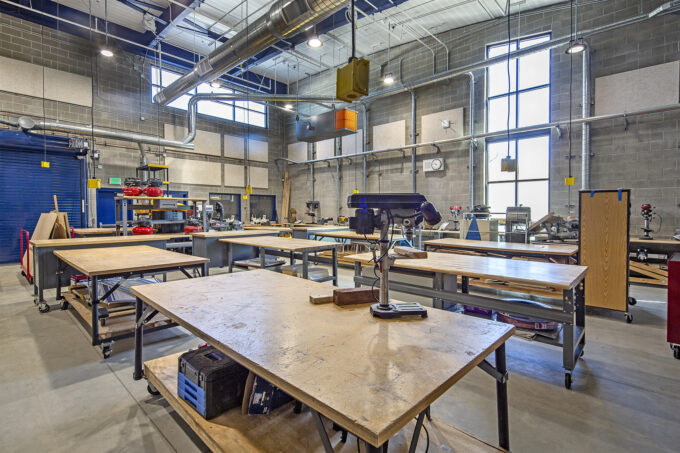Career Technical Education (CTE) spaces have existed for many years. Your district may have had a wood shop or an auto shop program to provide students with real-world trade experience when you were in school. Over the years, whether due to low funding or a higher priority on preparing students for college, these programs decreased in popularity. Today, there is a significant labor shortage in many skilled trades, which provide a good income without a four-year college degree. And, for some students, college is not their goal. Either they have no desire to earn a degree, or they cannot afford to go. With a more hands-on learning experience for all students and a direct pathway to a post-graduation career, CTE programs are attracting more students, and schools are expanding their programs to better address the needs of their students and communities.

Open concept CTE classrooms are flexible and allow for the space to adapt to changing curriculum. (Photo by John Swain)
Benefits of CTE Programs
No matter what post-graduation path a student takes, whether they decide to pursue a college program or a postgraduation career, CTE programs connect them with valuable real-world applications to prepare them for today’s jobs. CTE programs focus on problem-solving, mimic real-world work environments, and offer more engagement than a traditional classroom, benefiting students across all their classes. For students who do not plan on attending college, these programs help them learn a skilled trade and secure a job after high school. For those interested in pursuing a college education, CTE may be a first experience that inspires a new area of interest and helps them succeed in higher education.
Types of CTE Programs
CTE programs address the school, community, and local workforce needs and include agriculture, arts, entertainment, construction, child development, culinary, business, healthcare and nursing education, robotics, cybersecurity, and eSports. New industries and technologies are constantly being introduced, and the sky is the limit as to what CTE programs would benefit today’s students.
Connecting with Industry
A CTE program can flourish when a school incorporates industry tie-ins and hands-on experience. At Kennedy High School in Los Angeles, we designed a master plan for their career pathways program, including a screen-printing program. The school partnered with a local screenprinting business that helps the students develop real-world skills and learn more about the industry. The school also has a large percentage of students navigating immigration issues. A local law firm brings paralegals to campus to help, while allowing students to shadow them and gain a valuable understanding of the legal profession.
Folsom Cordova Unified School District has developed a relationship with Sacramento Valley Manufacturing Association (SVMA), the local Los Rios Community College District, and Sierra College to help students move directly into a career or a degree program. The partnership with SVMA has helped them develop CTE facilities across their district. At Folsom High School, the group reviewed design plans and equipment lists, and illustrated all the skills and training they require of their new hires to help build the best facilities possible to prepare students for their post-graduate school plans.
The CTE facility at Folsom High School features a shop, lab, and classroom spaces for learning in a broad and diverse set of disciplines, such as product innovation, graphic design, game development, and video production. The machine shop connects to one of the classrooms via a window allowing supervision and observation. The labs/classrooms are shared with the physics program, and feature sinks, lab worktops, and power drops from the ceiling at each workstation. Oversized doors open onto a work yard, which serves as a staging and utility area for materials and large projects. We strategically planned the design so that the various programs could work in sync within the space and included slab stabilization for vibration control, dust control, compressed air, and technical power needs of the machinery.
Designing for a CTE Program
When planning for a CTE program in your school, you must understand your students’ needs and any prominent industry and workforce needs. Once you’ve chosen the appropriate programming, a qualified designer will consider the industry-specific equipment and space the program will need. Depending on the program, new or remodeled spaces will need specialized design touches not usually considered in a traditional classroom, such as high ceilings, roll-up garage doors, a realistic medical office environment, or connections to existing programs and classrooms.
In California, there are currently more than 37,000 job openings in the cybersecurity industry. Funded by California CTE funds and Measure M, the design of Moreno Valley Unified School District’s (MVUSD) Canyon Springs High School’s new Cyber Innovation Center converted existing auto and wood shop spaces into a hands-on lab and classroom for cyber security education.
The new space aims to meet California’s current cyber security and gaming demands, training students in cyber security, programming, logistics, critical thinking, and teamwork. The program began seven years ago as an after-school program in a small classroom. The 7,686 SF Cyber Innovation Center supports the district in encouraging students to solve the clear and present challenges facing our society and prepare students to continue their education and pursue a career in this in-demand industry.

CTE classrooms can be a space for product development, STEM, media, or digital transformation.
As educators and designers committed to meeting students where they are and creating spaces that help them thrive, we should support them on the pathways that fit them best. For students who want to pursue careers that do require a college degree, these CTE programs can spark a new interest or give them an early start in their chosen profession. But college is only a pathway for some, and students who do not plan on pursuing higher education should be given every opportunity to thrive outside of high school. An innovative CTE program is a powerful motivator for their journeys.

